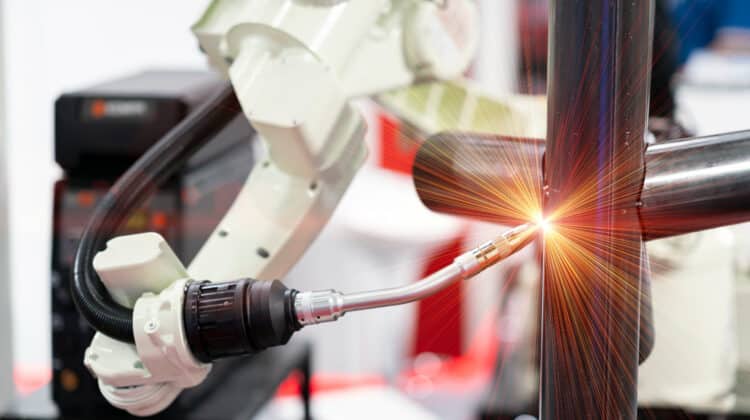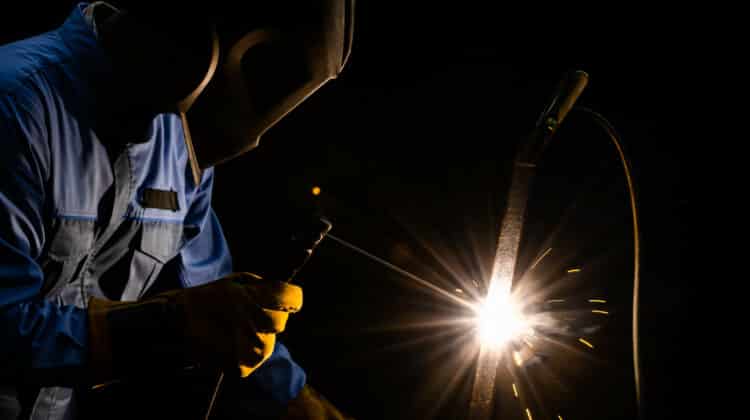If you have ever wondered what is the purpose of welding flux, keep in mind that its main function is to take off any oxidized metal from the material to be welded.
Also, it is used to protect the heated metal from reacting with atmospheric air which can lead to further oxidation. The welding flux achieves this by forming a gaseous shield around the welded part.
Flux is a blend of a number of chemicals, alloys, and minerals. The main function of these materials and chemicals is to ensure that the molten weld metal is protected from any type of contamination as a result of exposure to atmospheric air containing nitrogen, oxygen, and more contaminants in the environment. Adding these chemicals, alloys, and minerals as a flux to the weld provides a level of stability to the control arc as well as mechanical elements.
Some other roles of flux in welding include controlling the shape of the bead, determining penetration, helping in the removal of slug, adding alloying properties into the weld, controlling the mechanical elements of the weld, and reducing the possibilities of cold cracking in the weld by controlling the hydrogen.
Table of Contents
Why is flux so important in welding?
Welding flux is commonly used in metallurgy and metal joining. The main function of flux in welding is to prevent the formation of oxides, which is to ensure that during welding, there will be no oxidation of the base and filler materials. This is because some metal oxides may affect the metal and weaken the welds.
During the process of welding, there is a notable change in temperature on the filler and the base metal. This happens within a short period of time. Within the process, the heated metal may connect with the air from the environment and this will lead to oxidation. In turn, an oxide layer will be created on the weld and this will reduce the strength of the weld.
There is a high possibility of metals mixing with gases like nitrogen, which is abundant in the environment, causing the metals to be affected by inclusions as the oxide layer strips the metal of its corrosion resistance.
The strength of the weld is also affected, which is why technicians ensure that during welding, oxygen doesn’t get to the weld seams.
The primary environment that enables weld stationery to the metal being welded. This implies that there should be no reaction between the flux and the metals.
Weld flux is also important in welding because it reduces the platter, slows down the cooling time, and helps prevent hardening. It also takes out impurities from the molten metal and creates a protective slag over it.
Functions of flux in welding
Some of the most important functions of flux include:
-
- Flux helps to reduce spatter in welding.
-
- The weld flux brings in deoxidizers and helps purify the weld metal.
-
- As the welding process takes place, the flux melts and constructs a shielding layer on all sides of the arc. This prevents atmospheric gases from reacting with the weld.
-
- The welding flux produces gases to replace the oxygen and nitrogen in the environment. As such, a gaseous shield is also created around the arc and molten weld area.
-
- The weld flux coating forms a solid coating on the weld as it cools off.
- If iron powder or ferroalloys are added during the welding process, the flux coating help to increase the rate of deposition in the weld.
Here are major advantages of weld flux:
-
- Production of crack-resistant welds as a result of low-hydrogen coating.
-
- Due to deep penetration, electrodes with heavy coating are able to create high-quality welds.
-
- The cellulose coating provides a high rate of burn-off and influences deep penetration.
-
- As a result of iron oxide coating, the welding flux is able to produce welds with a better appearance.
-
- The flux also helps protect the finished weld from atmospheric gases by producing a slag on the weld metal.
-
- Current intensity, as well as arc voltage, are all controlled by the weld flux coating.
-
- The flux introduces alloying elements through the coating.
-
- By controlling the viscosity of the slag, the welding flux makes vertical and overhead welding both possible.
-
- Weld flux helps to achieve a smooth weld surface by controlling the weld bead profile.
- In addition, the flux coating on the electrode insulates the electrode enabling its functions at a higher current without the challenge of overheating. Also, when the metal cools off, it is easy to take out excess flux using a brush and warm water.
Difference between MIG welding and flux welding
MIG welding and flux welding are the common welding methods, there has been a long-standing debate regarding which is the best. In this section, we will explore their differences and what makes each of them peculiar.
Metal Inert Gas welding popularly known as MIG welding is a type of welding method where an electrode gun is used to feed electrodes into the weld. Unlike the case of flux welding, in MIG welding, a shielding gas instead of flux coated electrode to protect the weld from atmospheric interference.
In general, MIG welding is capital intensive as the equipment used in MIG welding are expensive than that of arc welding. Also, the equipment used in flux-cored arc welding is much more portable than those of MIG welding. Flux welding facilitates ease of mobility because there are only a few components to transport as there is no system needed to send air to the weld.
For a beginner in welding, it is advisable to go for MIG welding as the process is much easier to carry out than flux welding. The welder only needs to operate one component per time, whereas, in flux welding, there is the need for more professional welders who can handle multiple components at a time.
Due to external factors such as rain and wind, which can drastically reduce the strength of the weld, MIG welding doesn’t stand a chance outdoor. It is ideal for indoor welding operations. On the flip side, flux welding can do well both indoors and outdoor regardless of the weather conditions. There are no limitations of such.
For metals with thin to medium thickness, it is advisable to use MIG welding because there is no need for deep penetration. However, for metals that are thicker, flux welding is a great choice because of its deep penetration qualities which make it more effective here.
Types of electrode flux
In welding processes, flux is coated with electrodes. In some cases, the electrode uses the flux in them in a hollow cavity.
Here, the electrode envelops the flux. In the case of arc weld landscape, electrode flux is divided into four types depending on their properties.
-
- Basic flux — Basic flux is produced from shielding compounds such as magnesium carbonate, calcium carbonate, and calcium fluoride. Although basic flux functions better for high-strength steel, the arc is mostly less predictable and is unable to provide operational stability or perform out-of-place welds. However, one of the advantages of basic flux is produced more superior mechanical properties as well as low hydrogen diffusion levels.
-
- Iron oxide coating — The iron oxide coating is made up of a blend of metallic oxides which when heated generates an acidic molten slag. These metallic oxides include silica, iron, and manganese. During this process, a high level of oxygen is produced which makes it unfit for welding metals that are easily affected by oxygen inclusion. A practicable way to avoid this is to introduce deoxidizers.
-
- Cellulose electrode coating — It utilizes a mixture of cellulose and some organic compounds. During the welding process, if the cellulose is subjected to high temperature, disintegrates to form carbon monoxide and hydrogen which shields the weld from the atmosphere and ensures better penetration, although the hydrogen produced in excess may not be ideal for welding metals that have hydrogen inclusion properties.
- Rutile electrode — Rutile electrode is formed from titanium oxide. It is referred to as the most welder-friendly flux because it provides the welder with great arc control as well as slag control. Electrodes in rutile electrodes flux produce less amount of toxic fumes.





